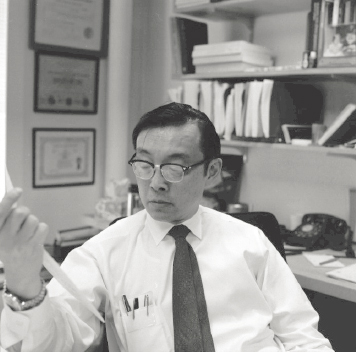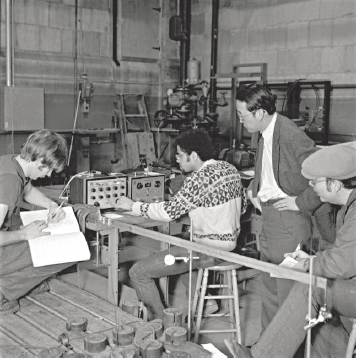

JAMES W. MAR
1920–2017
Elected in 1981
“Leadership in research and education in aerospace structures and composite materials, and for service to his country.”
BY DANIEL E. HASTINGS
JAMES WAH MAR, a prominent aeronautics and astronautics professor and researcher at the Massachusetts Institute of Technology (MIT), passed away peacefully on March 4, 2017, a week shy of his 97th birthday. He was recognized for his innovative work in structures, aeroelasticity, and materials. Those of us who knew him remember him as a scholar, an educator, a friend, and above all a kind and gentle person who always offered sage advice.
He was born to Fook Wah Mar and Mabel Chin Mar in Oakland, California, on March 10, 1920. The family moved to Seattle, Washington, where he graduated from Garfield High School. He initially enrolled in the University of Washington in 1938. In an interview for a history of the Air Force Chief Scientists,1 he said, “My father wanted me to be a doctor but I couldn’t stand the sight of blood.” What he was good at was mathematics; “I could do the multiplication tables and things like that,” he joked. “In 1938, without telling anybody, I applied for admission to MIT.”
He enrolled at MIT as a sophomore and received his SB in 1941 in civil engineering. He then worked as an aeronautical
___________________
1 Published in Lightning Rod: A History of the Air Force Chief Scientist’s Office by Dwayne A. Day (University Press of the Pacific, 2005).
engineer with Curtiss-Wright in Buffalo, New York, from 1941 to 1944 before enlisting in the US Navy (1944–46). He returned to MIT for his SM (1947) and PhD (1949), both in civil engineering, and then joined the faculty of the MIT Aeronautics Department, where he served for the next 41 years, retiring in 1990.
Mar’s research focused on advanced filamentary composite materials and large structures in space. He made major contributions to understanding of the fracture mechanics of various kinds of composites. His work in crack propagation at bimaterial interfaces was particularly notable.
His MIT career included his designation in 1980 as the Jerome C. Hunsaker Professor of Aerospace Education and a term as head (1981–83) of the Department of Aeronautics and Astronautics and its Division of Structures, Materials, and Aeroelasticity. He founded and directed both the Technology Laboratory for Advanced Composites and, with Rene Miller, the Space Systems Laboratory. He was instrumental in creating the unified engineering subjects, which became the well-known foundation of the department’s undergraduate education. And he chaired numerous faculty committees, including the Committee on Admissions and Financial Aid, Committee on Engineering Education, the Athletic Board, and the Independent Activities Period.
In 1970–72 he took leave from MIT to accept appointment as the US Air Force Chief Scientist, the first person of color to serve in this position. As chief scientist, he helped the Air Force understand the structural problems on the B-1, F-111, and C-5.
Throughout his career he took on numerous advisory assignments, including NASA’s Space Systems and Technology Advisory Committee, the FAA’s Technical Oversight Group for Aging Aircraft (chair), and government panels examining development of Air Force and Navy jet engines and the operation of the Air Force Logistics Command and Military Airlift Command.
He served on quite a few National Research Council boards and committees, including as vice chair of the panel that provided a technical evaluation of the Space Shuttle’s solid
rocket booster redesign following the 1986 Challenger disaster (1986–89), chair of the committees on the Status and Viability of Composite Materials for Aircraft Structures (1985–87) and on Technology to Enhance Logistics Performance on Fielded Weapon and Support Systems (1991–93), and member of the Aeronautics and Space Engineering Board (1978–83) and Air Force Studies Board (1987–93).
Mar’s substantial contributions were recognized with various honors. Besides his election to the National Academy of Engineering, he received the US Air Force Decoration for Exceptional Civilian Service twice, for his work as chief scientist and on the Air Force Scientific Advisory Board. In 1983 he gave the invited 24th SDM lecture of the AIAA, ASME, ASCE, and AHS, and in 1987 he received the AIAA Structures, Structural Dynamics, and Materials (SDM) Award for “extraordinary contributions in research,…outstanding leadership in research and development in the Air Force, NASA, and the aerospace industry;…[and] notable accomplishments in engineering education.” In 1992 he was elected an AIAA honorary fellow, the institute’s highest honor.
Those who knew him remember him as a kind person who gave prescient advice. MIT aeronautics and astronautics professor Paul A. Lagace, who began his MIT aeronautical education as one of Mar’s students, said, “Jim Mar was an outstanding person in many ways, making significant contributions to aerospace engineering, to the institute, and to the aeronautics and astronautics department. But most importantly, he sincerely cared about, and helped, each student with whom he worked. I wouldn’t be where I am today without all he did for, and with, me.” Indeed, as a testament to his effectiveness in the classroom, it may be worth noting that four of his students went on to land on the moon.
Institute Professor and former secretary of the Air Force Sheila Widnall was one of Mar’s advisees as an MIT undergraduate in the late 1950s. “Jim was a giant in the field. His expertise and his passion really shaped the AeroAstro department,” she said. She recalled a semiserious hurdle that he suggested for department faculty candidates, which became
known as the Jimmy Mar Test: “Jim would say that if an airplane flew over and the candidate didn’t look up, that candidate didn’t belong in our department.” This test has served the department well over the years.
Several former Air Force chief scientists and former chairs of the Air Force Scientific Advisory Board (SAB) remember his influence. Michael Yarymovch said, “Jimmy was my predecessor once removed. I learned a lot from him about the role of chief scientist and continued the tradition. We will all miss him as the great intellect he was.” Natalie Crawford, former chair of the Air Force SAB, remembered that, “During the early years of my involvement with the SAB he was a member…[and] very active. Always soft spoken. And always willing to teach a very new person. He was a gentleman and a scholar and a treasured mentor.” An accomplished tennis and squash player, Jim assured his MIT colleague and new SAB member Larry Young that it was perfectly acceptable to carry a tennis racquet onto the Air Force jet for SAB meetings. As a former Air Force chief scientist, the author of this tribute is pleased to acknowledge that I also benefited directly from Professor Mar’s excellent advice during my term.
Jim is survived by his wife of 75 years, Edith Lew Mar; their children Chris (Susan Rice), Cori, and Tim (Eliza Ward); four grandchildren; and a great-granddaughter. He was preceded in death by daughter Karen Lew Mar Walker and daughter-in-law Maureen Kivlin Mar.
James Mar will be sorely missed by all who interacted with him. He had many accomplishments but it was his kindness that people will always remember.
His service to the country, to the profession of aeronautics and astronautics, and to MIT was exemplary. We shall carry on his example.






